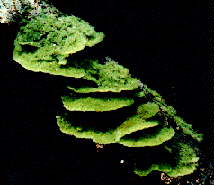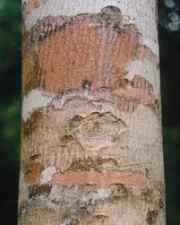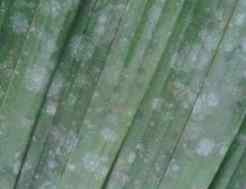Lichen

Photo: Courtesy of David Catcheside
These vary in appearance, resembling small volcanoes, cups or jam tarts. Lichens grow on rocks, walls, trees, fences, roofs and on the ground, as well as on leaves. They are very hardy in natural conditions, living in the tropics, on mountain tops, in salty seashore splash zones and even polar regions, where they survive temperatures well below freezing.
Fungus and Algae - Lichens were previously regarded as individual plants, just like any other member of the plant kingdom.
- However the nature of lichens is now better understood, and they are classed separately as an association of a fungus and an alga that form a single thallus because the two organisms are so intertwined.
- The fungus component of the lichen is known as the mycobiont, and the algal component is known as physobiont.
- The lichen thallus represents a mutualistic symbiosis from which both organisms benefit.
- The fungus draws up water and minerals (with hyphae) that the algae can use.
- The alga uses its chlorophyll for photosynthesis to manufacture food.
- It seems the algal cells are protected from high light intensity.
- Generally the fungal threads create the body of the lichen with the algal cells living within them.
- This gives the lichen strength and prevents the alga from drying out.
- The fungi also manufacture a type of acid which serves to eat away at underlying rock and provide the lichen with a foothold.
- Lichens therefore erode rock, very slowly.
- It is a very important balance that exists between the fungus and the alga in the lichen thallus. If disturbed in favour of either, disassociation may result and perhaps so might the destruction of the less-favoured organism.
- This symbiotic relationship can also enable the combination to survive in environments where neither partner is likely to survive alone.
- They are limited by light, needed by the algae for photosynthesis, and they also need clean air.
Habitat and Distribution: - Lichens occur in a variety of habitats from the Arctic to the Antarctic and all regions between.
- They can be seen on exposed rocks in the desert, solidified larval flows, the bark of trees, the leaves of plants, and particularly in the tropics.
- Lichens that grow on rocks are called Saxicolous, and are important in initiating soil formation. This is either by chemical means (secreting lichen compounds that weather the rocks on which they live) or mechanical means (directly destroying the rock by the physical action of the lichen thallus).
- Phycobionts have been induced to undergo rapid cell division in laboratories. The green algal symbionts multiply by vegetative cell division and by the formation of aplanospores.
Types of Lichen: - There are three main types of lichens:
- Crustose lichens, Foliose lichens, Fruticose lichens.
- Crustose lichens form flat crusty plates.
- They grow very slowly outwards around the margin, increasing their radius by as little as 0.5mm a year.
- Foliose lichens are leafy in appearance, although lobed or branched structures are not true leaves.
- They often grow near mosses.
- Fruticose lichens are even more finely branched and may hang down like beards from branches or grow up from the ground like tiny shrubs.
- These last two are particularly fussy about clean air but grow faster than the crustose lichens.
Additional Information: - It has been estimated that they produce a centimetre of topsoil in two thousand years.
- Many lichens produce small powdery granules called soredia on their surface.
- When washed or blown away, or carried by insects, they grow into new lichens.
- Sometimes the fungal partners make their own fruiting bodies.
- When these burst, the fungal spores are dispersed but if they do not pair up with the correct algal cells they cannot develop.
- The algal cells, on the other hand, are able to live independently.
- The presence of sulphur dioxide. produced when fuels such as coal and oil are burned, and which is responsible for acid rain damage, kills lichens.
- These plants are therefore good indicators of a clean environment.
- Since some are more tolerant of pollution than others, the type of lichen growing can tell us how bad the pollution is.
- They can stop growing if conditions are dry, resuming when moisture returns and are usually the first organisms, to invade barren ground, such as new lava flows..
Human Uses: - Lichens were used traditionally in many countries to make dyes for cloth.
- The dye litmus is derived from lichens.
- It changes to red when exposed to an acid, and blue when exposed to an alkali.
- An infusion of the lichen lungwort was used for treating coughs and asthma.
- Reindeer `moss', the staple diet of reindeer and caribou in winter (when nothing else grows) is actually a lichen.
- Unfortunately, because lichens tend to accumulate certain environmental contaminants, after the Chernobyl nuclear power plant accident in 1986 reindeer `moss' accumulated so much radioactivity that the Saami people who live in the Arctic were unable to eat their reindeer.
(Courtesy of: Environmental Protection Agency, Cairns.) Additional Information: Damon Ramsey Lichen is actually a life-form that is the result of an inter-dependent relationship between two very different organisms; usually a fungus and an algae, (or a cyanobacteria, a common occurrence in the lichens lower down in the rainforest strata). While biologists are still not exactly sure what the true dynamics of the relationship are, generally speaking the algae usually provides the food through photosynthesis, while the fungus provides protection from the elements as well as mineral nutrients. The result is a very successful and diverse group of organisms that can inhabit habitats all over the world, including some of the harshest environments on the planet.  In the tropical rainforests, different types inhabit different zones in the rainforest, as can easily be observed by examining a typical trunk with it's different colours at different levels (left). In one survey, biologists found over 170 species of lichen on one single individual Quandong tree in the New Guinea tropical rainforest.

They are similarly common in the Australian rainforests, from the micro lichens that look like paint on the tree trunks, to the splashes on every leaf (right), to one of the most recognizable groups of macro-lichens, the 'Old Man's Beards', Usnea spp., which are bunches of stringy material hanging from the branches.
One of the most recognizable groups of macro-lichens is the Old Man's Beards which are bunches of stringy material hanging down from branches. Can be seen hanging down from branches over the water on the Lake Barrine cruise.
Script: Courtesy of Damon Ramsey BSc.(Zool) Biologist Guide |
